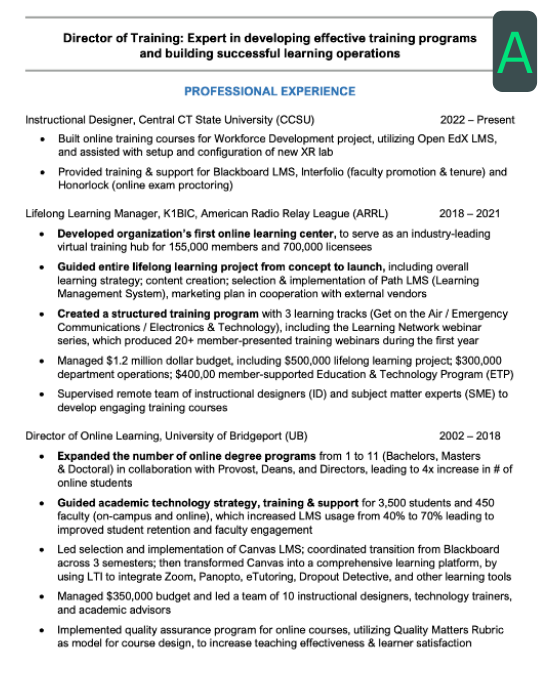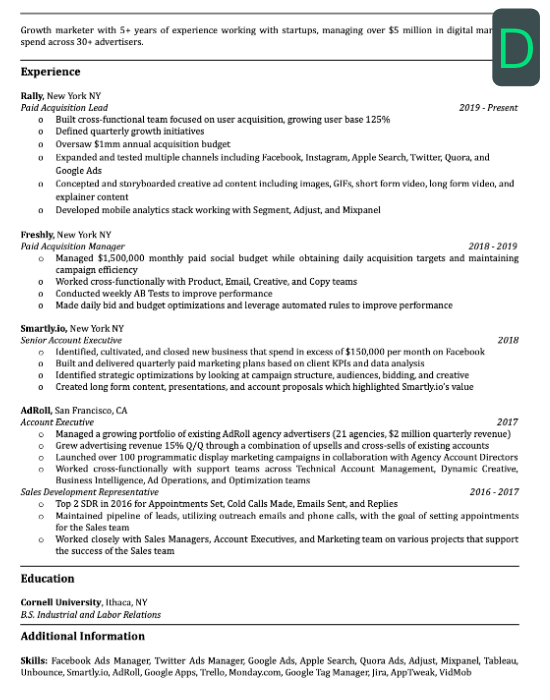
Resume Bullet Points: How to Write Genius Bullets in 4 Simple Steps
There are 3 key pieces to any job-winning resume: your skills, your projects, and your resume bullet points.
On average, 250 people will apply to every job opening. Of those applicants, about 6 people will be called in for interviews, and one person will get the job.
Often times, the difference between being called in for an interview and being passed up lies within your bullet points.
👉 If you know you have strong skills and you’ve been applying to jobs, but not getting any interviews, this post is for you.
In this post I’ll show you:
- Why bullet points are better than paragraphs
- A proven formula for writing powerful bullet points
- Our proprietary system we use on every resume we review
- A bullet point generator that can do 90% of the work for you
As you read this post, I recommend supplementing it with this post about the best AI-powered resume builders (and why you should use one).
I also recommend watching our free resume course which goes into more detail about these techniques.
Alright, let’s jump in!

Should you use resume bullet points or paragraphs?
Before we jump into how to write resume bullet points, first we should discuss whether using bullet points on your resume is even best.
When you’re writing your resume, you have three choices:
- You can write bullet points
- You can write sentences
- You can write paragraphs
Based on working with hundreds of job seekers, the best resumes tend to use bullet points, not paragraphs, and I’ll explain why.
👉 According to eye-tracking studies, a recruiter will spend between 10–30 seconds reviewing your resume. And here’s why:
Many job seekers have a slightly romantic view of what the hiring process looks like. They might picture a recruiter sitting down with a hot cup of coffee in a quiet room, with only one thing on their screen: their resume.
The truth is that this hardly ever happens.
Most recruiters are incredibly busy (and often overworked). They are often in charge of multiple roles, not just the one you’re applying for.
👉 On average a recruiter will review between 100–200 resumes per day.
That means that they need to review those resumes quickly.
It’s only natural that with such a big workload and limited time, recruiters will gravitate towards the resumes that are easiest and clearest to read.
This is why you should use resume bullet points instead of paragraphs on your resume.
But don’t take my word for it. Let’s do a little experiment.
👉 Try this:
- Take a look at the following 4 resumes below
- Don’t worry about reading them.
- Just based on visual looks, which one would you gravitate towards most.
Swipe right to see resume examples
When we ask this question in our free resume workshops, both job seekers and hiring managers gravitate towards resume B about 90% of the time.
That’s because the resume bullet points in this resume example are much easier to read than the paragraphs and sentences in the others.
Bullet points are simply easier to read than paragraphs (this is also why our most popular cover letter template uses them as well).
Recruiters are people just like you and I, they gravitate towards the easiest resumes first, and those resumes are the ones that use bullet points.
How many bullet points should you have per job on a resume?
One of the most popular techniques I teach in our free resume course is the 4–3–1 rule.
This rule simply says that your resume should have:
- 4 bullet points per job
- 3 jobs per resume
- 1 line per bullet point
Now, this rule is definitely flexible, so let’s break down what this means exactly.
One of the biggest mistakes job seekers make when they’re not getting interviews is to think, “it must be because I don’t have enough experience.”
So what do they do?
They add more bullet points.
Here is an excerpt of a real resume that was submitted to me for a resume review:

☝ This person followed the best practice that bullet points are easier to read, but then they went completely wild with them.
Having this many bullet points defeats the entire purpose of the 4–3–1 rule, which is to make your resume easier to read.
👉 The maximum number of bullet points you should have on your resume PER JOB is 5.
5 bullet points per job is best because it lets you show a variety of your experience, while still keeping your resume clean and easy to read.
Now, that’s the maximum. But, I usually recommend having 4 bullet points per job when you can as it will help make your resume just that bit more clean.
Here is a short video from our free resume course where I explain the 4–3–1 rule in more detail:
How to write great resume bullet points
Writing eye-catching resume bullet points can be tricky, especially if you’re not a natural born writer.
But fear not! I’ll show you a formula that makes writing great bullet points super easy.
There are 3 pieces to any bullet point:

Every great resume bullet point has:
- A power verb
- A method/skill
- A result
Let's break down each of these pieces and how you should approach writing each one.
1. How to choose your resume bullet point verbs
Before you start writing your bullet points, the first thing you want to do is understand the 5 types of bullet points that you can write.
There are 5 categories of bullet points:

Of course, there are a lot of synonyms to these verbs, but these are the 5 main categories.
The easiest way to show the full breadth of your work experience is to choose one verb from each of these categories.
You can actually check if you’re showing your full range of experience on your resume by color coding these resume verbs like this:

When you color code your verbs, you’ll quickly be able to spot where there are gaps. Here is an example of a resume that I reviewed, which had great bullet points.
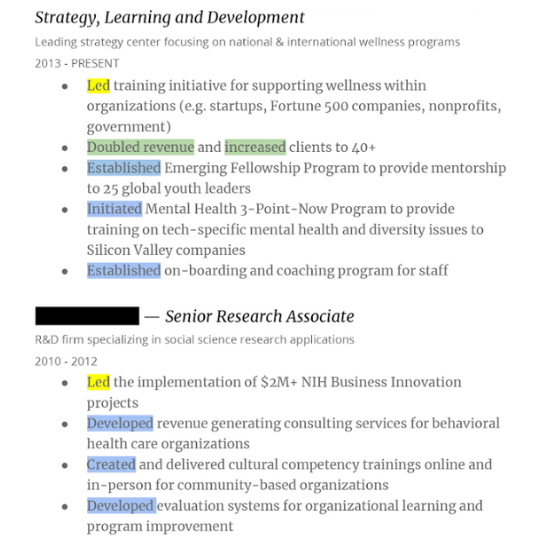
After I color-coded it, however, you can see that it was very focused on one skill set (build type skills). The bullets were good, but they weren’t showing this person’s full range of skills.
Using this system, we were able to quickly find the duplicate resume bullet points that weren’t needed and replaced them with new bullets to show this person’s full range of accomplishments:
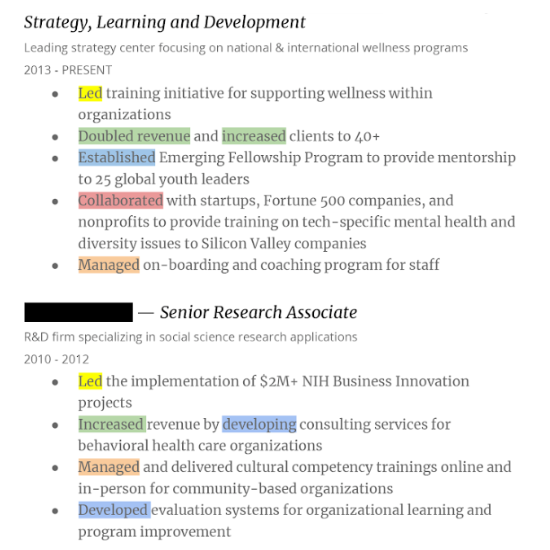
So, as you write your resume bullet points, make sure you’re using a good diversity of verbs and make sure they’re all “power verbs.”
Here is a great article by Iowa University that has a huge list of resume power verbs.
2. How to choose your resume bullet point skills/methods
After the verb, the next part of your bullet points will be the skill or method you want to showcase.
This part of the bullet is relatively self-explanatory, but there are a few things to keep in mind.
The most important thing to focus on when writing your resume bullet points is that they’re relevant to the job description.
When you’re in the thick of a job search, it can be hard to keep straight whether your resume is on target for the jobs you’re applying to.
This is one area where modern tools can really help.
One of my favorite tools for checking my resume bullet points is Teal.
Teal is a free tool that can help you organize your job search, build your resume, and even check your bullet point relevance.
Teal works in 3 simple steps:
- You upload your resume
- You upload the job description you’re applying for
- Teal will show you how well tailored your resume is for that specific job description.
Here is an example of what the Teal scoring system looks like:
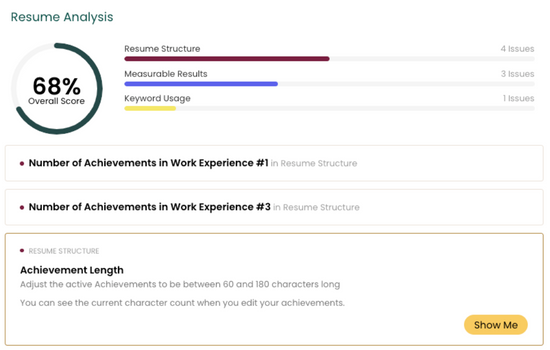
If you’ve never tried Teal, I highly recommend creating a free account and playing around with the tool.
(Teal also has a chrome extension, which is super useful as you’re browsing job sites.)
3. How to add results to your resume bullet points
This is the part of resume bullet points that 99% of job seekers forget about, but it’s arguably the most important.
After you’ve explained what you’ve done through your verb and method, the last step is to explain what it resulted in.
This is what separates good bullet points from great bullet points.
Career expert and professional resume writing coach, Claire M. Davis, explains this concept best in this short video:
Basically, the best way to figure out this section of your bullets is by adding the phrase “…resulting in…” to your resume bullet point.
This will naturally force you think, “what was the impact of this thing that I did at my job?”
4. How to add metrics to your resume bullet points
Once you’ve added the 3 ingredients to your bullets, there’s one last ingredient that can put the cherry on top: numbers.
A lot of job seekers struggle with how to add metrics to their resume bullet points.
This is especially true if you’re in a profession that doesn’t have a lot of metrics. But the truth is that pretty much every single job has something that can be quantified.
Gillian Kelly, an award-winning career coach, joined us recently to explain how to add metrics to your resume bullet points:
To figure out how to add metrics to your resume, Gillian Kelly recommends asking these 4 questions:
- How much?
- How many?
- How often?
- How much better?
These 4 questions are so simple, but they can really help you to find some metrics for your resume.
👉 But, let’s say that you’re in a profession where you might not have tracked any metrics, such as customer support.
One way you can add metrics is by estimating your impact based on your own experience.
Let’s say one part of your job is to solve customer complaints. And let’s say you estimate that you answered about 20 complaints per day.
That means you answered 400 complains per month.
You also might know that of those 400 complaints there were about 7 that you couldn’t resolve and had to pass on to your manager.
All of a sudden your mediocre bullet point of:
- Resolved customer complaints
Became an amazing, eye-catching bullet point like this:
- Resolved 400 monthly customer complaints with a 98% success rate.
☝ Add a few more bullet points like this to your resume, and you’ll be landing interviews in no time!

Resume Bullet Point Generator
Now that you know how to write great bullet points, let’s talk about some helpful tools.
While I highly recommend you write your own bullet points, there are times when getting some assistance with your bullets can be helpful.
👉 Here I’ll share 3 ways to get help with writing your bullet points (in order of least expensive to most expensive):
1. Resume Bullet Point Generator
Resume tools have come a long way in the the last 5 years. If you haven’t used any resume writing tools recently, I highly recommend trying one of these top 4 resume builders.
These builders now have powerful AI tools that can generate resume bullet points for you. These are definitely worth trying out, even if it’s just to get ideas for writing your own bullets.
And the best part? All 4 of these tools are free to use!
2. Members-only group
If you have some more specific questions about how to write your bullet points, we do have a private member community at GHYC. When you join our GHYC community you’ll get access to our private chat group.
In the chat group, you can post any job search questions you have and I’ll personally respond to your message. You can even request a full resume review and get a full audit in less than 3 days.
It’s a great way to get that little extra guidance you need and our reviews speak for themselves.
The group costs less than $10, so come try us out!
3. Hire a resume writer
If you have a more complex job search ahead of you, then hiring a resume writer may be a worthwhile route to go. We have a list of the 10 best resume writers we recommend here (along with their prices).
Takeaways & Next Steps
There you have it! That’s how to write resume bullet points that will actually land you interviews.
As you write your bullet points, remember:
- Keep them short
- Keep them relevant to the job description
- Keep them results focused
Writing resume bullet points instead of paragraphs or sentences is one of the best ways to improve your resume.
And remember, you don’t need to write your bullet points the old-fashioned way. You can use several tools to help you:
- Use an AI-powered Resume Builder (free)
- Use our Resume Course (free)
- Join our private job search group (less than $10)
If you have any questions as you start writing your resume bullet points, remember you can always reach out to me on LinkedIn and ask.
And if you enjoyed this post, you can get more like it delivered straight to your inbox by dropping your email below:
---
Read more resume, LinkedIn, and interview best practices on The GHYC Blog.More from the blog

How To Ask Why You Didn’t Get the Job (That Will Actually Get a Reply)
How To Ask Why You Didn’t Get the Job (that will actually get a reply) "Thank you for your...
77 LinkedIn Headline Examples That Will (actually) Get You Noticed
77 LinkedIn Headline Examples That Will (actually) Get You Noticed According to a recent JobVite...
7 Creative Job Application Ideas To Get an Employer’s Attention
7 Creative Job Application Ideas To Get an Employer’s Attention If you’ve been applying to jobs...
Like this? Try our free courses!
Tired of sending your job applications into a black hole and never hearing back? Get hired faster with our guided courses all for FREE!
Bogdan Zlatkov is the Founder of GHYC and author of "The Ultimate Guide to Job Hunting", ranked #1 on Google. He has been featured in the Wall Street Journal, Fast Company, HR Dive, and more. At GHYC, Bogdan creates job search courses & tools by working with award-winning career coaches, best-selling authors, and Forbes-Council members. Prior to GHYC, Bogdan led the content programs at LinkedIn Learning.
